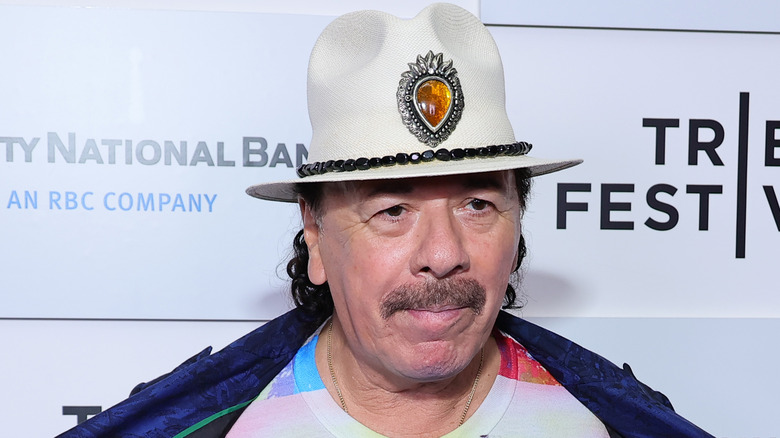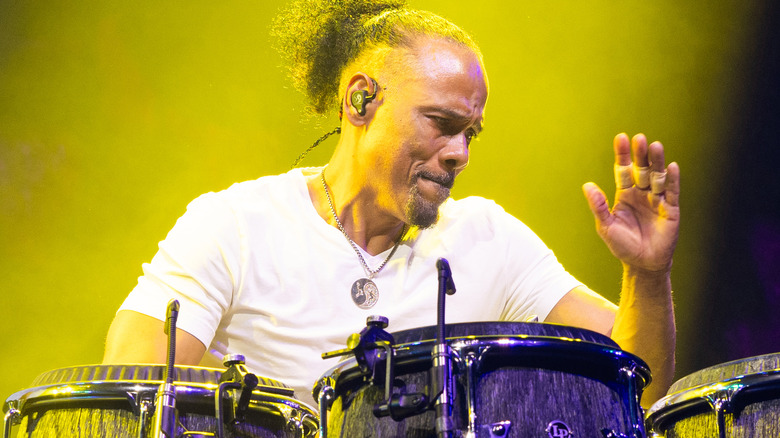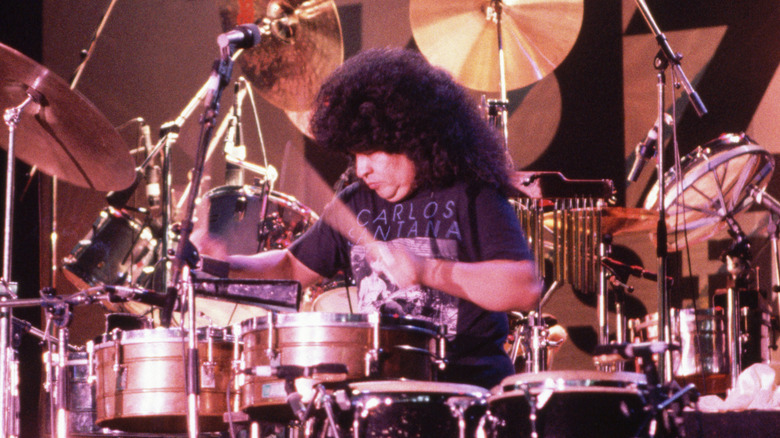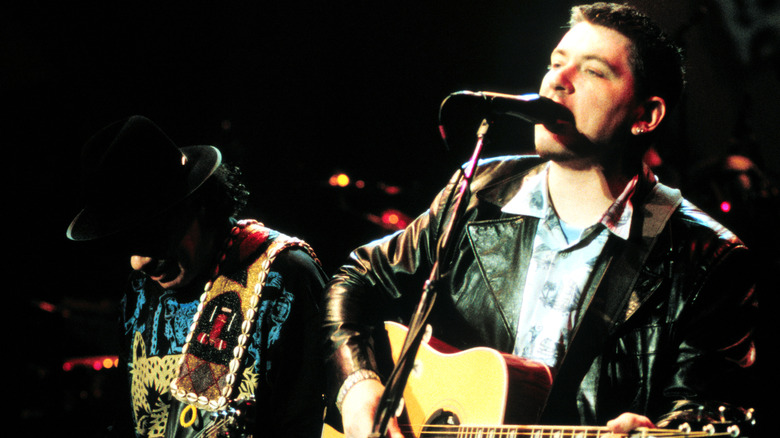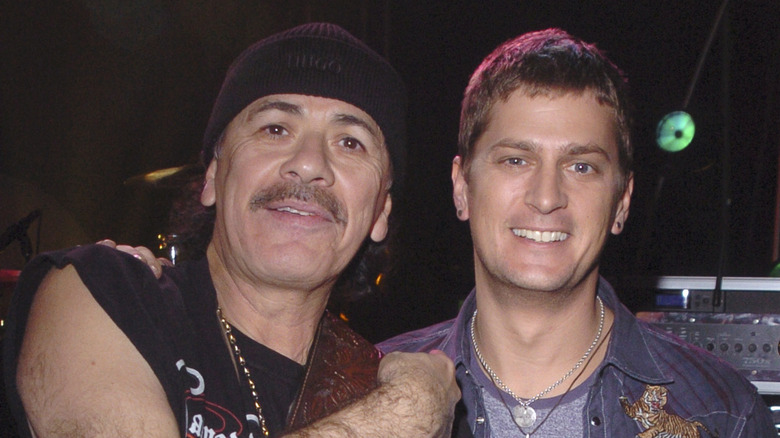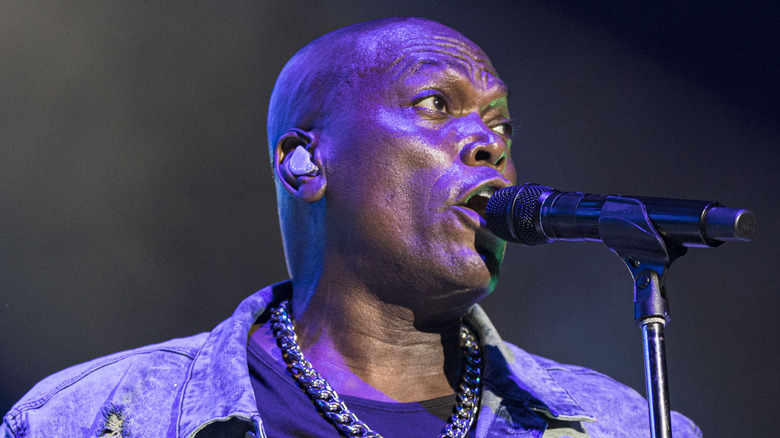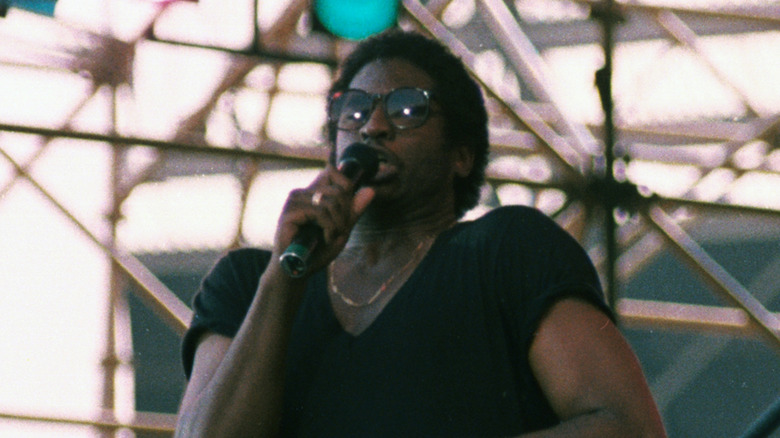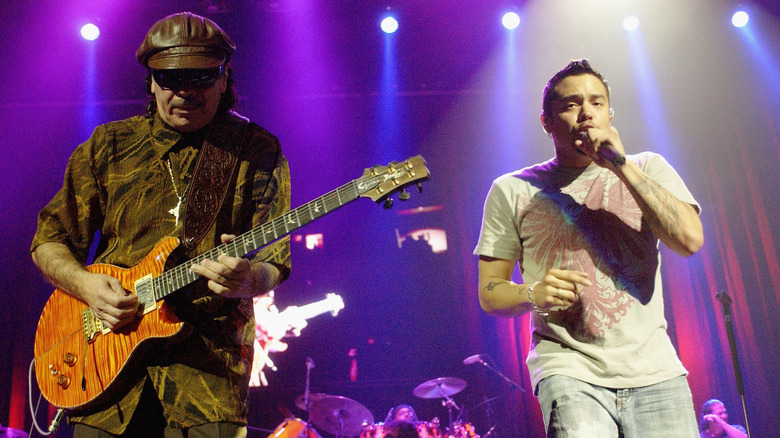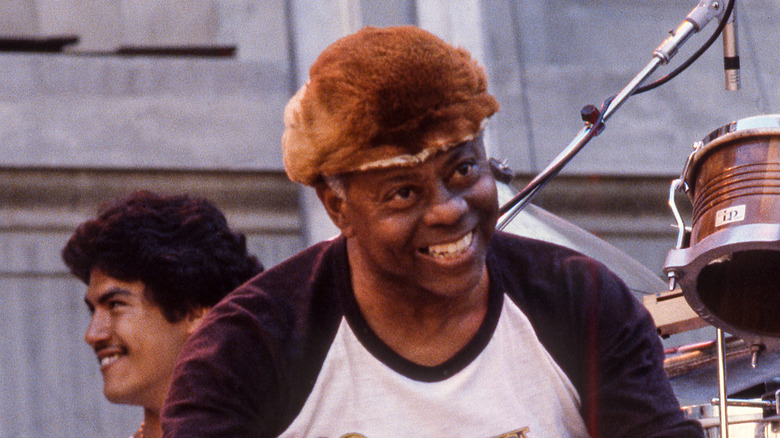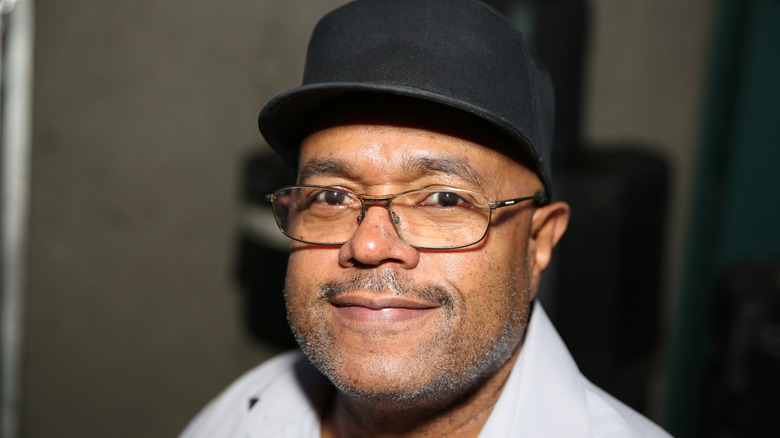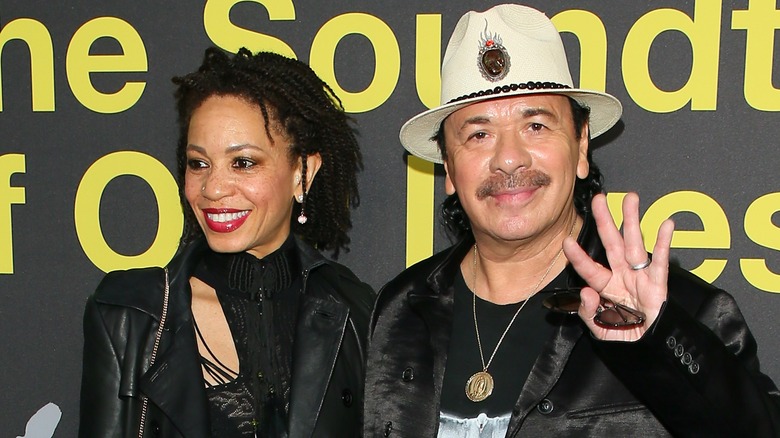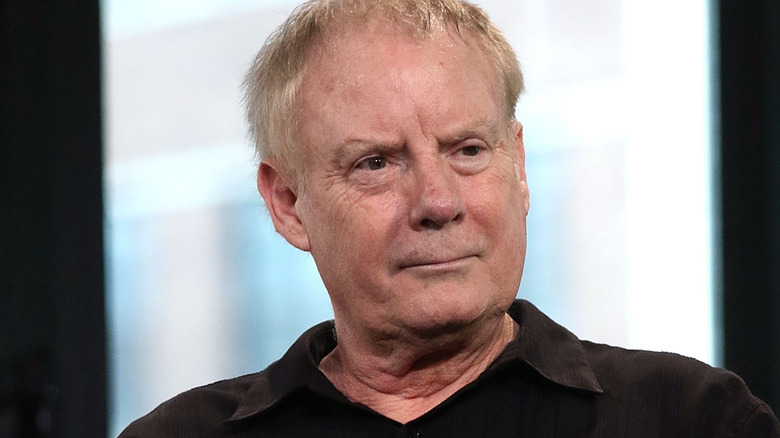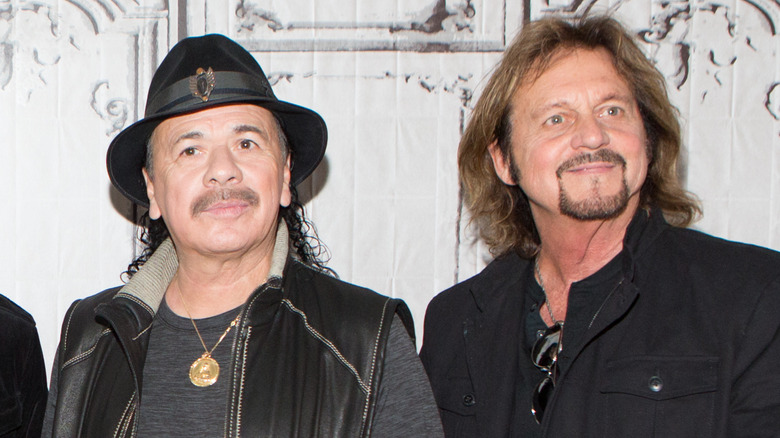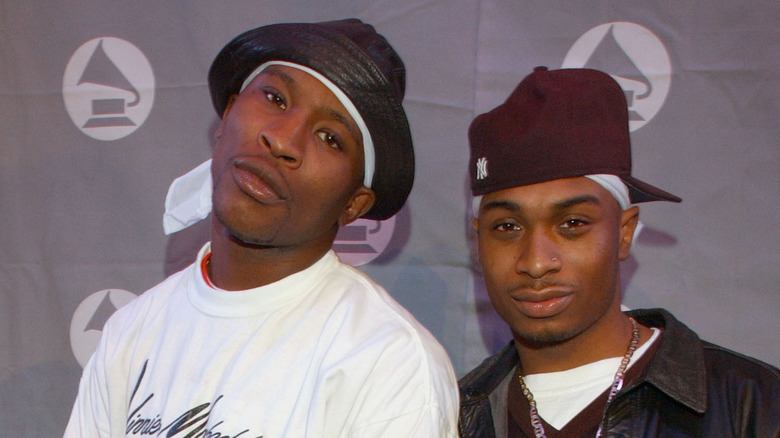What Carlos Santana's Former Bandmates Have Said About Him
Carlos Santana has been a public figure since the late 1960s, after a star-making performance at Woodstock. He's since sold millions of records and entered the sometimes controversial Rock and Roll Hall of Fame as the front man and musical force behind the band Santana, impressing critics and delighting fans with his masterful guitar playing. He even created a whole new style of music, combining psychedelic rock, jazz, blues, traditional Latin American elements, and pop.
Starting out with the Santana Blues Band, which would evolve into Santana, Carlos Santana has persistently given off vibes that he's all about two things: music and spiritual matters. This makes for a charismatic if inscrutable person, and to decode the words and actions of Santana, it takes those who know him best. The lineup of his band has constantly changed and evolved, and Santana has collaborated with countless musicians, on record and on stage. Working with Santana had a profound effect on many of them. Let's uncover the untold truth of Carlos Santana and find out what the guitarist is really like, and what it's like to work with him, according to his bandmates past and present.
Paoli Mejias
Regarded as one of the best living conga players in the world, Puerto Rico-born Paoli Mejias formed his Paoli Mejias Latin Jazz Quintet in 2005. He paused work on that project in 2013 when he was asked to be the conguero and versatile percussion instrumentalist in the touring version of Santana, replacing a succession of musicians that bandleader Carlos Santana didn't feel were quite right for the job.
Vibing with the boss and all the other musicians on stage is extremely important in Santana, and to Carlos Santana himself. "This is a big organization led by a megastar. And it requires certain energy, a positive attitude on stage, and they found this in me. Carlos says that he sees the light in me, those are his words, not mine," Mejias told Bienvenidos in 2018. "He told me that he sees in me something he expects of band members: to be someone that adds positively not only in the music but in the good energy, the discipline, the ability to get along with the rest of the band, and the idea is that this energy projects itself on the stage to the audience."
Jose Chepito Areas
Timbales are free-standing, two-headed drums similar to tom-toms or timpani, traditionally played in Latin American musical styles. Nicaraguan musician Jose "Chepito" Areas is one of the most accomplished timbales players in the world, and in the late 1960s he left the popular San Francisco Latin rock band The Aliens to join the Santana Blues Band at the behest of its creator, Carlos Santana. He'd still be a part of the group, renamed Santana when it switched focus from blues to Latin rock, when it played Woodstock and recorded its first, self-titled album.
After that incarnation of Santana began to splinter in the 1970s, Areas continued working with Santana. "Carlos knew I was doing less drugs and he couldn't find anybody like me," Areas told Classic Rock Review. "He still hasn't. He wanted that sound." However, when that initial lineup reunited in 2016, Areas wasn't asked to participate. "It's been hard trying to get close to Carlos throughout the years, even in the early days," Areas explained. "I feel he has been somewhat distant even though he's been there. We've had a love/hate relationship."
Everlast
Everlast attended the 2000 Grammy Awards, the ceremony in which Santana's collaborative album "Supernatural" won nine trophies. Among those wins was a Grammy for Best Group Rock Performance for the gritty, bluesy dirge "Put Your Lights On," composed by the song's vocalist Erik Schrody, a.k.a. Everlast, a rapper who became a singer-songwriter after the demise of the '90s one-hit wonders House of Pain. The song, featuring an interplay of Carlos Santana's guitar with Everlast's singing, was a big hit on Billboard's rock and alternative rock charts in the fall of 1999.
Despite "Supernatural" winning so many awards and eventually selling 15 million copies, Everlast doesn't think the success spoiled or even changed Carlos Santana in any meaningful way. "His vibe is the same no matter what. He's just the most gracious, spiritual dude you'd ever meet," Everlast said (via the Hartford Courant) just after the 2000 Grammy Awards. "He's happy, but I don't think this is affecting his energy."
Rob Thomas
Carlos Santana enjoyed the biggest individual success of his career in 1999 with the hit "Smooth." A smash hit across multiple radio formats that spent 12 weeks at No. 1 on the Billboard pop chart, "Smooth" was the lead-off single from Santana's comeback album "Supernatural" which found him playing his distinctive guitar licks while major pop and rock singers of the era took on lead vocal duties. His collaborator on "Smooth" was Rob Thomas, lead singer of the popular soft rock band Matchbox Twenty, who also co-wrote the song.
The Thomas-Santana team-up was short-lived by design, but working alongside Santana for only a little while left Thomas with a new approach to music. "That the record was put together just so – through sound, it could change people's molecular structure. And he sat me down and explained to me that that, as a musician, is what we do," Thomas told Rolling Stone. "You can play one note and change the way people feel. You don't want to try to ever quote Carlos, because it never comes out as eloquent as it does when he said it, and it sounds hokey coming from me, of all people, I guess, but it gave me my new purpose on why I do what I do."
Ray Greene
Santana is one of the few bands named after a front man in which that front man doesn't sing. The group requires a vocalist and in 2016, Ray Greene was tapped to be one of two alternating lead singers for the band on tour, a job that began immediately and ended his previous run as the vocalist for Tower of Power.
Within weeks, Greene was bewitched by Carlos Santana and caught a glimpse into how the guitarist approaches his art. "Santana sees music way differently than a lot of people do, which is cool. He's never settling, he's always trying different things," Greene told "Berklee Today" five months after he joined the Santana band. "As long as you can be on the same wavelength with him, it can be a really cool experience. You get the sense that all he wants to do is play, he just loves playing the guitar."
Greg Walker
Primary early Santana vocalist Gregg Rolie left the band in 1971, leaving an opening for a singer to share the front of the stage with Carlos Santana. Greg Walker of the pop group A Taste of Honey, who'd later score some disco-era hits like "Boogie Oogie Oogie," ended his association with that group when Santana wanted him to be their lead singer. In 1975 he made the move and sang on albums like "Inner Secrets and "Moonflower."
From his decade or so with the group, Walker fondly remembers Carlos Santana's leadership skills, and how he would routinely and naturally take great pains to make his musicians feel comfortable, welcome, and valued. "Graham Lear, Carlos really lifted him up, told him he liked where he played the solos," Walker told "Museum of Making Music" about one particular Santana drummer. "That's Carlos Santana, man. He just tried to lift you up in any way he possibly could." To that end, Walker said, Santana would get funny. "If he thought that you were under, maybe a little shy, he'd do something. He'd start telling jokes or something to make you come out of whatever you was in."
Andy Vargas
After staging one of the biggest comebacks in rock history with the Grammy Award-collecting, multi-platinum 1999 album "Supernatural," Carlos Santana took his eponymous band out on its biggest tour in years, the Supernatural World Tour. At that point, singer Andy Vargas, a performer of Latin American musical styles who'd signed his first recording deal as a teenager, was hired to provide the vocals for all those newly popular and classic Santana songs alike, on stage, every night. Vargas subsequently fronted Santana on around 20 different tours and recorded occasionally with the band, too.
Still getting his career off the ground and forging his musical identity, Vargas found a guiding force in Carlos Santana. "Carlos has been an amazing mentor to me both in music and personally. He has pushed me, well, he has pushed all of us in the band to reach greater limits with our talent," Vargas told SounDarts. The singer also discussed the unique origin story of a song he recorded with Santana called "Do You Remember Me." "I remember when Carlos brought this song to us in rehearsal. It was not long after it came to him in a dream," Vargas recalled.
Armando Peraza
An acclaimed percussionist from Cuba sought out for his bongo and conga playing, Armando Peraza brought an authentic Latin American sound to Santana the band, as well as a resume of sideman gigs with the likes of Dave Brubeck, Dizzy Gillespie, and Charles Mingus. Peraza enjoyed a particularly strong bond with Carlos Santana, and he'd become one of the longest-tenured musicians in Santana, playing live and on albums from 1972 to 1990, and returning for the special concert event into the 2000s, not long before his death in 2014.
Carlos Santana considered Peraza a mentor and idol. Peraza thought highly of Santana, too, particularly his tendency to bring in overlooked but talented musicians and then subsequently take care of them. "Carlos Santana lets you play. The better you play, the more he hire you," Peraza told Congahead in 2007."He has a great humanity principle as a musician. He protects the underdog people."
Dennis Chambers
A go-to drummer for R&B, jazz, and rock bands, Dennis Chambers has spent time supporting bands like Parliament Funkadelic, Steely Dan, George Duke, and, from 2005 to about a decade later, as the touring drummer in Santana. When previous drummer Chester Thompson departed Santana in 1984, he recommended Chambers to replace him, but it didn't work out until he got another chance two decades later.
While aware of Carlos Santana's reputation as an exacting band leader, his lasting image of the guitarist is of an artistically voracious and driven individual, and one with whom it can be hard to keep pace. "He is a very genuine and giving person to be around," Chambers told All About Jazz. "Carlos listens to a lot of music, a lot of different types of music. He would hear something he liked and it would inspire him to incorporate a sound or an idea into his music. It wasn't unusual for him to bring us these changes and want to incorporate them into our shows right away."
Cindy Blackman Santana
Before she joined Santana, drummer Cindy Blackman factored significantly into the lesser-known life of Lenny Kravitz. A solo act, a jazz band leader, and session musician, Blackman found some fame when she joined Kravitz's band as a drummer in live gigs and in music videos. She held the job from 1992 until the mid-2000s, a few years before she first provided the rhythm for Carlos Santana's live collective.
In 2010, Blackman got a call to play drums in the place of double-booked regular Santana drummer Dennis Chambers. "I remember when I first played, I was like, 'wow, this feels really free,'" Blackman told the "Music is My Life" podcast of her initial musical encounter with the guitarist. "It felt like there was a nice beautiful freedom there, and the music kind of floated. It was really, really wonderful."
Then, as things got more professional between Santana and Blackman, things got more personal, too. "We started communicating about the songs and about the music," Blackman recalled. "Then we started communicating about spiritual things and philosophies, and then, like a relationship just grew really quickly from there. Late in 2010, after Carlos Santana and his first wife split after 30 years, he married Blackman. In 2014, Cindy Blackman Santana became an official member of Santana.
Mike Shrieve
When Carlos Santana was ready to record the first album under the Santana moniker, he solidified his band's lineup and installed Mike Shrieve on the drums. Shrieve's persistent percussion can be heard in all the early milestone moments in the band's history, including its first two albums and the hit singles "Evil Ways," "Black Magic Woman," and "Oye Como Va," and he was behind the kit when Santana played Woodstock.
Shortly after joining the band and participating in a grueling rehearsal session, Shrieve asked Santana to attend a movie with him. They set out on foot, but Santana abruptly stopped on the way. "'Man, what do I want to go to the movies for? I want to be the movie,'" Shrieve recalled the guitarist saying, to the Hudson Union Society. "And then I realized it's true. This is a different cat."
Shrieve remains in awe of Santana's musical aptitude and passion. "With Carlos, it was like we were meant to be together," Shrieve told "The Jack Feinberg Show." "Because what he was searching for, he had that same, and still does by the way, the same sort of searching for the right note and the right tone and a master of melody. He's like an encyclopedia of melodies."
Gregg Rolie
On "Evil Ways," "Oye Como Va," "Black Magic Woman," and all those early Santana hits that established the band's sound and reputation in the late 1960s, Carlos Santana's guitar meshed with the vocals of Gregg Rolie. An original member of Santana, Rolie left the band to form Journey in the 1970s, where he continued to play keyboards and sang until Steve Perry took over as the main vocalist in one of the most successful band member replacements ever.
"Carlos plays from his heart, period. And if it doesn't have that, it won't have anything for you," Rolie told the Hudson Union Society in 2016, four decades after his initial departure from Santana's group. "You can see him when he plays, if we give that to him, he gives it to us. If we all have that, we give it to you." Rolie also suggested that Santana's celebrated guitar prowess itself stems from the musician's emotional connection to music. "He plays different notes, different themes, 'where does that come from?' It's always been different. But mainly, he's not playing with his head, he's playing with his heart."
The Product G&B
In April 2020, the latest single from Santana's "Supernatural" hit the radio: "Maria Maria," featuring the emerging hip-hop act The Product G&B. The duo, vocalists David McRae and Marvin Moore, had their biggest hit they ever wound, with the song spending 10 weeks at No. 1 on the Billboard pop chart.
Signed to J Records, a subsidiary of Arista Records, label boss Clive Davis tapped The Product G&B to contribute to "Supernatural," his pet project then in the works. McRae and Moore weren't all that excited about the proposition because they didn't know who Carlos Santana was, but they met him for the first time in a recording studio to create "Maria Maria." "He came in with magic marker drawn on his sneakers, and we were thinking, he's a guy who brings in the guitars or something, and he's actually Santana," Moore told Billboard. "You would have thought he was somebody's grandfather coming from the bus stop, real talk." But when everybody got everything sorted out and started making music together, it was "magical," according to Moore, adding that it "was a genuine mesh, a synergy, and it just worked."
